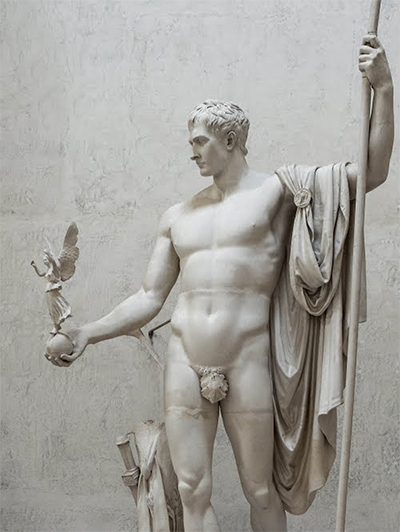Napoleon as Mars the Peacemaker, a huge heroic nude statue that stands 3.45 metres tall, was sculpted by Antonio Canova between 1802 and 1806.
The statue depicts French Emperor Napoleon's head on the Roman god Mars' body. He's holding a Victory or gilded Nike standing on a spherical object in his right-hand side. In his left-hand side, he's standing on a staff. At his side, a belt and a sword are draping on the tree stump. Mars is portrayed as having brought peace; he has now put his armour and arms aside.
Who Commissioned the Statue?
It was commissioned by Napoleon Bonaparte when he was the First Consul of France at 33 years old. He summoned the Italian sculptor Antonio to Paris and told him to produce a propagandistic statue to depict himself as a peacemaker of the French Revolutionary Wars after signing two treaties that ended separate wars with both England and Australia. Napoleon was proficient at propaganda, so he wanted his image to appear in several media to increase his prestige.
Location of the Statue
It took several years before the statue was transported to France; in April 2011, Napoleon saw the statue for the first time before it was displayed in the Louvre Museum in Paris. In 1816, the British government purchased it from Louis XVIII and granted it to the 1st Duke of Wellington. The duke gave the statue pride of place in his house stairwell. The floor was strengthened to carry the weight of the statue. The marble statue is currently on display in the stairwell that was owned by the Scottish neoclassical architect Robert Adam, which is located at Apsley House (Duke's London residence).
Plaster Casts
Antonio had the marble statue cast in plaster and 5 copies were produced. They were destined for the Italian Accademie di Belle Arti. The best-preserved of the copies is now in the Brera Art Gallery (Pinacoteca di Brera), Milan's main public gallery for paintings. It was initially sent to Padova after being divided into 8 sections. However, because it wasn't paid for, it had to stay in its packing-cases.
The viceroy Duke of Leuchtenberg, who was Napoleon's nephew, bought it and was displayed in the Galleria Reale in the monumental palace Palazzo di Brera between 1809 and 1814. It was transferred to Accademia's storerooms and stayed there until 2008. In 2009, it was restored then installed in the Brera Art Gallery for the two-hundredth anniversary of the gallery.




